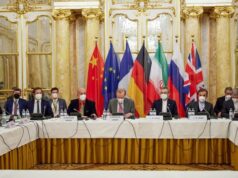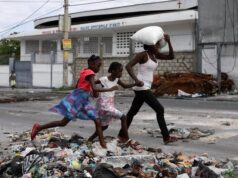China’s still building detention camps in Xinjiang — and they’re getting even bigger

By
Michael Walsh
This large high-security facility in Xinjiang only opened in January 2020.
China appears to be expanding its network of secret detention facilities for Uyghurs and other Muslim minorities in Xinjiang, despite official claims that all detainees have been released from the camps.
Key points:
- A thinktank says it has identified 380 of China’s detention camps in Xinjiang
- It says at least 60 camps have been expanded, and 14 are still under construction
- China says all detainees “graduated” from the facilities late last year
New research from the Australian Strategic Policy Institute (ASPI) suggests that China has continued to build new detention centres in Xinjiang, with a focus on what the thinktank said were high-security “prison-style” facilities.
Researchers for ASPI’s International Cyber Policy Centre have used satellite imagery to locate and analyse a total of 380 suspected detention facilities in Xinjiang.

The China Cables leak of highly classified documents reveals the scale of Beijing’s repressive control over Xinjiang, where more than a million Uyghurs and other Muslim minority groups are detained.
And despite Beijing’s claim late last year that all detainees had “graduated” from the facilities, the thinktank said major detention camps were still in operation across Xinjiang.
“Our satellite evidence showed … at least 60 camps saw construction, and at least 14 remain under construction as of the latest satellite imagery available,” ASPI researcher Nathan Ruser told the ABC.
“There’s huge facilities, hundreds of them, that seem to be solely dedicated to the removal of people from society.”
More than 1 million Uyghurs and other Muslim ethnic minorities are believed to have been detained in Xinjiang’s sprawling camp system since the security crackdown there began in 2017.
Despite denying the existence of the camps for years, Chinese officials later took to describing the detention facilities as “vocational education and training centres”, where would-be terrorists were to be reformed and turned into productive members of society.
However, survivors, family members and camp whistleblowers have told a very different story, describing a system of arbitrary detention, political indoctrination, human rights abuses and forced labour.
China’s mass internment of its ethnic Uyghur population appears to be the largest imprisonment of people on the basis of religion since the Holocaust.
In a surprise twist, local officials announced in December 2019 that all detainees had in fact “graduated” from the centres, a claim activists and human rights groups were quick to dispute.
“The idea that they’ve released everyone, and that there’s no people currently extrajudicially detained in Xinjiang, is quite ludicrous … there’s so many people that still have no news of their families that were detained,” Mr Ruser said.
However, the “graduation” story has persisted, with China’s Foreign Minister Wang Yi repeating it last month while visiting France.
“All of them have graduated, there is no-one in the education and training centre now,” Mr Wang said, adding that “they all have found jobs”.
But now there may also be satellite evidence contradicting China’s claim.
In their analysis of the detention system, ASPI divided the 380 facilities it detected via satellite into four tiers based on the level of security at the sites.
Foreign journalists and diplomats have in recent years been given tours of “Tier 1” camps.
Tier 1 facilities are the least secure: they’re often former school buildings that were converted into detention centres through the construction of internal fencing and perimeter walls.
These are the facilities foreign journalists have previously been allowed to visit on guided tours. They appear to be mostly focused on political re-education, as opposed to some of the more prison-like facilities in the higher tiers.
But according to ASPI’s monitoring of satellite imagery, it seemed many of these facilities have been “desecuritised”, and in some cases appeared to be decommissioned altogether.
Tier 1 and 2 camps often have internal fencing, which is visible from satellite, and limit movement between buildings.(Supplied: Australian Strategic Policy Institute)
Internal fencing, barbed wire and external perimeter walls had been removed from many Tier 1 and Tier 2 facilities.
“So there seems to be a germ of truth perhaps in [China’s “graduation” claim”], in that a lot of people in the lower-security camps do appear to have been released, and this is corroborated by victim testimony as well,” Mr Ruser said.
“However, that’s only a small part of the detention regime.”
‘Prison-style’ camps may be on the rise
Some camps with guard towers, high walls and other security features are being expanded.(Reuters: Thomas Peter)
At the same time that some of the lower tier facilities were being wound back, ASPI said “prison-style” Tier 3 and 4 facilities have undergone significant new construction and expansion.
Tier 3 and 4 facilities are purely focused on the detention of prisoners, and feature high concrete walls, extensive barbed wire, watch towers and are often arranged in cell blocks.
ASPI’s research found that most of the 14 facilities still under construction in Xinjiang in 2020 were prisons, and around half of the 61 facilities that received recent construction work have been high-security camps.
A 3D rendering of a newly-built prison in Markit county, Xinjiang. It is larger and more secure than prisons in the region have typically been.(Supplied: Australian Strategic Policy Institute)
The thinktank said this may suggest a shift toward “higher-security prison-style facilities”, as opposed to the low-security re-education centres.
“It does fit in with the broader findings of victim testimony as well, that people are being transferred into higher security camps, or even sentenced to formal prison charges,” Mr Ruser said.
Chinese officials have consistently defended the country’s detention policies in Xinjiang, describing the centres as being a core part of China’s fight against terrorism and religious extremism.
The 2009 riots that led to some of China’s worst ethnic violence and set the wheels in motion for today’s internment camps in Xinjiang began in the most unlikely of places: a toy factory.
A Chinese Government White Paper on the camps released last year said the facilities “can effectively eradicate the conditions that enable terrorism and religious extremism to breed and spread”.
Beijing often attributes criticism of its Xinjiang policies from Western governments and rights groups to “ideological prejudice” and “double standards”.
The ABC has contacted the Chinese Government and embassy for comment.
In addition to the new research, ASPI today launched an interactive website to make its data on Xinjiang’s detention camps accessible to the public.
The Xinjiang Data Project went live Thursday afternoon, and features ASPI’s detention camp database, maps and satellite imagery.
“Largely it will be an interactive map, that allows you to sort of explore all the datapoints we found for the detention camps and a number of other elements of Xinjiang’s crackdown,” Mr Ruser said.
He said the plan is for the database to continue to grow, and for the Xinjiang Data Project to be “a living site that will keep being updated with analysis and data sets”.




